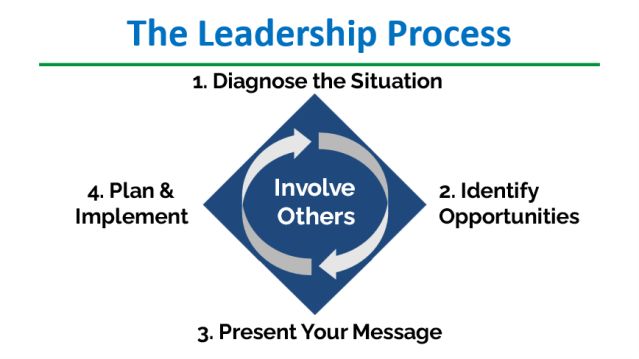This post was coauthored by Paul B. Thornton, MBA, M.Ed., who developed The Four-Step Leadership Process
All leaders have the same basic goal: to make things better and more efficient, and to help the people they lead perform at their best. The following 4-step model outlining the leadership process helps leaders understand how to lead more effectively. The overarching key, however, is to involve others in the leadership process.

4 Steps to Leading Effectively
1. Diagnosing the Situation. Before improvements can be made, the leader needs to understand the current environment, including what is working well and what the problems are. This requires getting input from others. In diagnosing, key questions can be asked by the leader, such as:
- What is the quantity and quality of the products/services currently being delivered?
- What are people (clients/customers, team members) feeling and thinking?
- What do the financial and operational metrics reveal?
- How do customers, suppliers, and team members perceive the current situation?
What Works Against Successful Diagnosis: The leader believes that he/she knows best and does not consulting with others. The leader relies exclusively on their own perceptions and is prone to personal biases and “blind spots” that get in the way of critical diagnosis. Also, surrounding yourself with “yes people” who are not willing to speak up critically and/or contribute their own perspectives can hamper successful diagnosis.
2. Identifying Opportunities for Improvement. By connecting with others—interviewing customers, team members, and outside experts—the leader should determine the one or two ideas that have the greatest potential impact and are feasible to achieve.
What Works Against Identifying Opportunities for Improvement: Resistance to change by the leader and/or team members (“don’t fix it if it ain’t broken”; resting on one’s laurels). All too often, leaders are satisfied with the status quo and don’t take the initiative to look for opportunities to improve and innovate.
3. Presenting the Message. Implementation requires acceptance by all key stakeholders. This includes higher-level leaders who need to improve and fund new ideas/programs and those who are directly affected by the proposed changes (i.e., team members, customers).
Some tips for presenting your message:
- Clearly define the problem and the opportunities.
- Use facts, examples, and compelling stories, as well as visual aids, to explain your ideas.
- Build confidence by sharing evidence from pilot programs or testimonials.
- Deliver your message with passion and conviction.
What Works Against Successful Presentation of Your Message: The leader’s message is overly complicated or poorly organized and articulated. The core ideas of the message may become buried in excessive details. A lack of enthusiasm or confidence in the message can limit its impact.
4. Planning and Implementation. A strong plan outlines the actions, resources, and timelines needed for success. This includes the actions, resources, and timelines required. Effective plans often include:
- Training and orientation to build knowledge and skills.
- New metrics to measure progress.
- Reward and recognition programs to reinforce desired behaviors.
What Works Against Successful Implementation: When the leader, or the team, delays and takes too long to adapt to changes it can defeat the innovation strategy. This occurs because of inflexibility (“it’s the way we’ve always done it before”) or an inability to make needed adjustments. In short, the very best leaders involve others and follow these proven steps.
